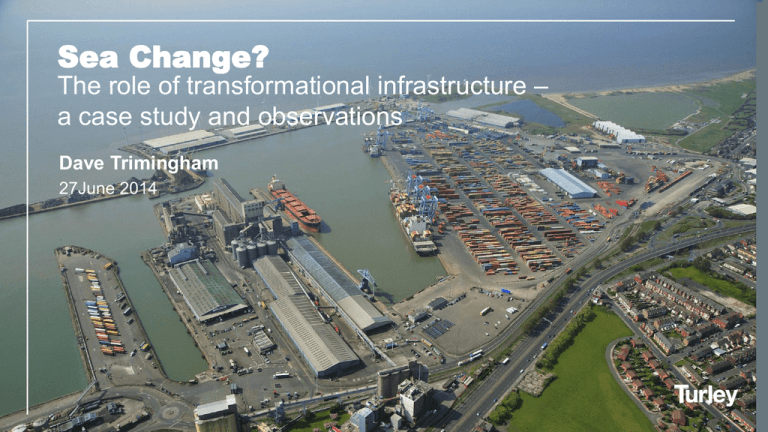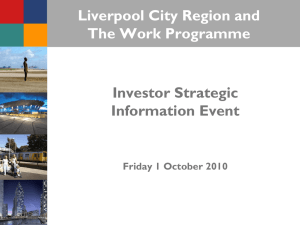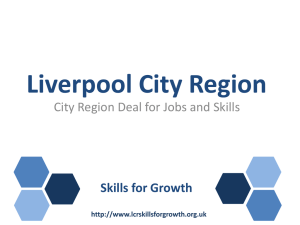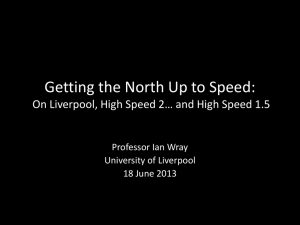Planning for Transformational Infrastructure
advertisement

Sea Change? The role of transformational infrastructure – a case study and observations Dave Trimingham 27June 2014 “Without adequate 21st century infrastructure these northern cities will have little chance of competing not just with London but with other cities around the world in the global economic race” Peter Hall, David Thrower & Ian Wray Town and Country Planning: April 2014 Overview Case study • Liverpool 2 in context • Implications for UK logistics • Implications for Liverpool Observations • Nationally significant infrastructure • Regional and local infrastructure • Responsibilities and process Liverpool 2 in context: where is it? • Port of Liverpool, Seaforth • ‘In-river’ Mersey • Central position within the UK Liverpool 2 in context: what is it? • Two new in-river berths • State of the art rail mounted cranes • Doubles container capacity at Port of Liverpool • £300m+ investment: supported by EIB and RGF • 4,600 jobs created Liverpool 2 in context: Global Shipping • Changes in supply and demand • Rising fuel prices and emission controls • Drivers to larger vessels – - Panamax - 5,000 TEUs - ‘Post-Panamax’ - 13,000 TEUs • Routes limited by capacity of infrastructure Panama Canal Widening 1. 2. 3. 4. 5. 6. 7. 8. Expanding Atlantic entrance New Atlantic approach channel Atlantic Post-Panamax locks Raise the water level of Gatun lake Widening and deepening of the navigational channel New Pacific approach channel Pacific Post-Panamax locks Expanding Pacific entrance Global Shipping Routes Implications for Port of Liverpool • New deep sea port in centre of UK • Reduced unit cost of transit • Point of entry closer to markets • Only deep sea port on UK west coast • Major new markets available • Rejuvenation of Liverpool’s port heritage Growth potential • Global container demand rising – 18% 2013-2016 • UK container imports forecast to rise • UK manufacturing exports rising • Distance and journey times to L2 favourable • Liverpool has unique advantage Manchester Ship Canal • 36km inland waterway to heart of Manchester • Built in competition – now complementary • Coastal vessels and barges to tri-modal Port Salford • 1.5million square foot portcentric logistics • Expansion potential to 5 million square foot • Significant further potential in multi-modal sites along MSC Logistics – The Golden Triangle A new model – Port-Centric Distribution L2 port-centric benefits Shipping • Three times larger vessels – efficiency savings At port • State of the art handling and stock control • Fewer environmental impacts On transit routes • Shorter road journeys • Reduced road traffic L2 conclusions • Driver of transformation of UK logistics • Move away from road to water and rail • Complemented by port-centric logistics facilities • Significant investment and job creation • Catalyst to further regeneration and growth Planning for infrastructure • L2 illustrates national and local dimensions • Varied procedures for components of scheme • Across multiple local authorities • Planned through Regional Strategy Planning for future infrastructure • If nationally significant, considered against NPS • Others considered against local plans • Regional co-ordination removed • Is duty to co-operate enough? • No clear process of planning for infrastructure • Emergence of other policy tools (even Neighbourhood Planning) Concluding remarks • Infrastructure development can be transformational • Co-ordinated approach and long term planning are essential • Development plan system is capable… but lacks strategic perspective • Duty to co-operate not up to the job • Infrastructure at least demands regional (if not national) perspective Observations on infrastructure planning Working well: Do better: • NSIP process – once proposals identified • Infrastructure delivery plans – essential local and social infrastructure • NIP – where needs already identified • Prioritising opportunities • Identifying sectors/projects that could deliver growth • Clear responsibility: Government/market and between departments • Consideration in spatial planning For discussion How is growth potential best identified? How are infrastructure priorities best dealt with through development plan? • Centrally? Which department? • Regionally? Apparatus has gone • Market led? How resolve conflicts? • Sectoral approach – public/private • Forward looking national plan? • Regional priorities as evidence base? ‘Duty to Co-operate Plus’ • Sectoral priority/action plans? Development Plan status? “It needs to be emphasised that … no-one is currently thinking or planning on this scale” Peter Hall, David Thrower & Ian Wray Town and Country Planning: April 2104











